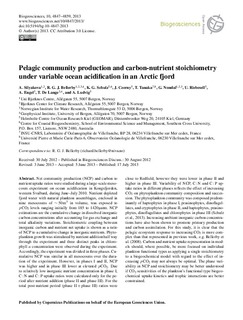| dc.contributor.author | Silyakova, Anna | |
| dc.contributor.author | Bellerby, Richard | |
| dc.contributor.author | Schulz, Kai G. | |
| dc.contributor.author | Czerny, Jan | |
| dc.contributor.author | Tanaka, Tsuneo | |
| dc.contributor.author | Nondal, Gisle | |
| dc.contributor.author | Riebesell, Ulf | |
| dc.contributor.author | Engel, Anja | |
| dc.contributor.author | De Lange, Tor | |
| dc.contributor.author | Ludvig, Andrea | |
| dc.date.accessioned | 2014-02-16T10:04:36Z | |
| dc.date.accessioned | 2014-03-28T14:48:51Z | |
| dc.date.available | 2014-02-16T10:04:36Z | |
| dc.date.available | 2014-03-28T14:48:51Z | |
| dc.date.issued | 2013 | |
| dc.identifier.citation | Silyakova, A.,Bellerby, R.,Schulz, K.G., et al., 2013. Pelagic community production and carbon-nutrient stoichiometry under variable ocean acidification in an Arctic fjord. Biogeosciences 10(7):4847-4859 http://dx.doi.org10.5194/bg-10-4847-2013 | |
| dc.identifier.issn | 1726-4170 | |
| dc.identifier.uri | http://hdl.handle.net/11250/193242 | |
| dc.description.abstract | Net community production (NCP) and carbon to nutrient uptake ratios were studied during a large-scale mesocosm experiment on ocean acidification in Kongsfjorden, western Svalbard, during June–July 2010. Nutrient depleted fjord water with natural plankton assemblages, enclosed in nine mesocosms of ~ 50 m3 in volume, was exposed to pCO2 levels ranging initially from 185 to 1420 μatm. NCP estimations are the cumulative change in dissolved inorganic carbon concentrations after accounting for gas exchange and total alkalinity variations. Stoichiometric coupling between inorganic carbon and nutrient net uptake is shown as a ratio of NCP to a cumulative change in inorganic nutrients. Phytoplankton growth was stimulated by nutrient addition half way through the experiment and three distinct peaks in chlorophyll a concentration were observed during the experiment. Accordingly, the experiment was divided in three phases. Cumulative NCP was similar in all mesocosms over the duration of the experiment. However, in phases I and II, NCP was higher and in phase III lower at elevated pCO2. Due to relatively low inorganic nutrient concentration in phase I, C : N and C : P uptake ratios were calculated only for the period after nutrient addition (phase II and phase III). For the total post-nutrient period (phase II + phase III) ratios were close to Redfield, however they were lower in phase II and higher in phase III. Variability of NCP, C : N and C : P uptake ratios in different phases reflects the effect of increasing CO2 on phytoplankton community composition and succession. The phytoplankton community was composed predominantly of haptophytes in phase I, prasinophytes, dinoflagellates, and cryptophytes in phase II, and haptophytes, prasinophytes, dinoflagellates and chlorophytes in phase III (Schulz et al., 2013). Increasing ambient inorganic carbon concentrations have also been shown to promote primary production and carbon assimilation. For this study, it is clear that the pelagic ecosystem response to increasing CO2 is more complex than that represented in previous work, e.g. Bellerby et al. (2008). Carbon and nutrient uptake representation in models should, where possible, be more focused on individual plankton functional types as applying a single stoichiometry to a biogeochemical model with regard to the effect of increasing pCO2 may not always be optimal. The phase variability in NCP and stoichiometry may be better understood if CO2 sensitivities of the plankton's functional type biogeochemical uptake kinetics and trophic interactions are better constrained. | nb_NO |
| dc.language.iso | eng | nb_NO |
| dc.relation.uri | http://www.biogeosciences.net/10/4847/2013/bg-10-4847-2013.pdf | |
| dc.rights | http://creativecommons.org/licenses/by/3.0/ | |
| dc.rights.uri | https://creativecommons.org/licenses/by/3.0/ | |
| dc.subject | VDP::Matematikk og Naturvitenskap: 400 | nb_NO |
| dc.title | Pelagic community production and carbon-nutrient stoichiometry under variable ocean acidification in an Arctic fjord | nb_NO |
| dc.type | Journal article | nb_NO |
| dc.type | Peer reviewed | nb_NO |
| dc.date.updated | 2014-02-16T10:04:37Z | |
| dc.rights.holder | © Author(s) 2013 | |
| dc.subject.nsi | VDP::Matematikk og naturvitenskap: 400::Zoologiske og botaniske fag: 480::Marinbiologi: 497 | |
| dc.subject.nsi | VDP::Mathematics and natural scienses: 400::Zoology and botany: 480::Marine biology: 497 | |
| dc.source.pagenumber | 4847-4859 | nb_NO |
| dc.source.volume | 10 | |
| dc.source.journal | Biogeosciences | |
| dc.source.issue | 7 | |
| dc.identifier.doi | 10.5194/bg-10-4847-2013 | |
| dc.identifier.cristin | 1052743 | |

